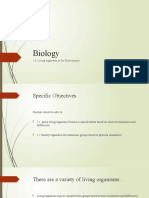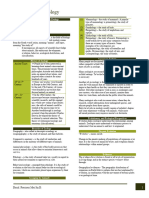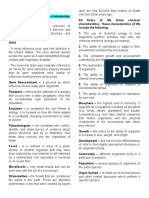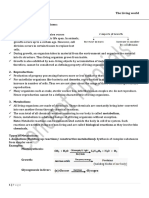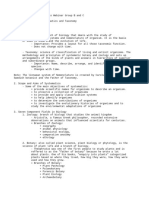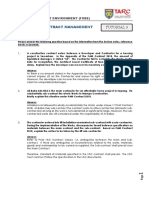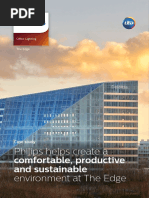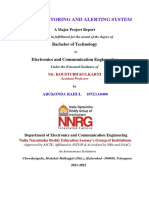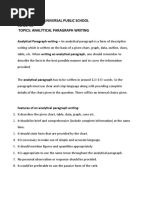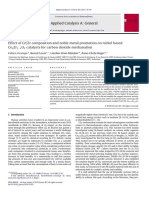0 ratings0% found this document useful (0 votes)
3 viewsReviewer in Zoology
Reviewer in Zoology
Uploaded by
Hazel Anngoodluck
Copyright:
© All Rights Reserved
Available Formats
Download as PDF, TXT or read online from Scribd
Reviewer in Zoology
Reviewer in Zoology
Uploaded by
Hazel Ann0 ratings0% found this document useful (0 votes)
3 views21 pagesgoodluck
Original Title
Reviewer-in-Zoology
Copyright
© © All Rights Reserved
Available Formats
PDF, TXT or read online from Scribd
Share this document
Did you find this document useful?
Is this content inappropriate?
goodluck
Copyright:
© All Rights Reserved
Available Formats
Download as PDF, TXT or read online from Scribd
Download as pdf or txt
0 ratings0% found this document useful (0 votes)
3 views21 pagesReviewer in Zoology
Reviewer in Zoology
Uploaded by
Hazel Anngoodluck
Copyright:
© All Rights Reserved
Available Formats
Download as PDF, TXT or read online from Scribd
Download as pdf or txt
You are on page 1of 21
Zoology CHAPTER 1 Grow and Develop.
All living things grow
BIOLOGY and develop during at least part of their
-Is the science that studies life. life.
-derived from Greek words BIOS-life Reproduce. Reproduction the process of
LOGOS- Study producing new organisms of the same
type. Process of producing new
ZOOLOGY organisms of the same type.
-is the scientific study of animals.
Adapt and respond to environment- All
-It is one of the broadest fields in all of the
science because of the immense variety organisms respond to stimuli. Plants
of animals and the complexity of the grow toward a source of light, and your
process occurring in animals. pupils dilate when you walk into a dark
room.
First Organisms Inhabiting the Earth Adopt- camouflage/ copy the
A. Kingdom Archeobacteria-
environment.
characterized by living in extreme
conditions. Respond- Makahiya(plant) Defense
Can live in very acidic environment/ Mechanism
salty/devoid oxygen Cells (Made up of cells). Smallest unit
Ex: Black smokers capable of all life functions. Cells are
B. Kingdom Eubacteria- The oldest either prokaryotic or eukaryotic. They are
known living things on Earth.
basically differentiated by the presence
The oldest fossils yet found are 3.5
billion year old cyanobacteria. (in eukaryotes-multicellular,tao,animals)
C. Kingdom Protista(Laging nag or absence (in prokaryotes-unicellular,
pro-protest) such as bacteria) of true nucleus.
1. Unicellular or Multicellular -basic structural and functional unit of all
2. Heterotrophs(consumers, forms of life.
grasshopper) or -consist of cytoplasm, enclosed within a
Autotrophs(producer,plants)
membrane and contains many
D. Kingdom Fungi
macromolecules such as proteins, DNA
1. Most are Multicellular(2 or more
and RNA
cells) ex. Mushrooms
Energy – Living organisms need energy
2. Heterotrophs (by ex- ternal
to grow, develop, repair damage and
digestion)nitrogen fixation
reproduce. Ability to do work.
E. Kingdom Plantae
1. Multicellular
2. Autotrophs SCIENCE(scientia)
F. Kingdom Animalia -systematic enterprise that builds and
1. Multicellular organizes knowledge in the form of
2. Heterotrophs testable explanations and predictions
about the universe .
MAJOR DIVISIONS
Zoology- study of animals
NATURAL SCIENCE
Botany- study of plants
Physical Sciences – It deals with the
Microbiology- study of the biology of
limited phase of the material universe.
microscopic organisms
Biology– It deals with the study of life.
CHARACTERISTICS OF LIFE
SOCIAL SCIENCE- It deals with human
DNA based on a universal genetic code.
relations
All organisms pass along hereditary
traits. Genes carry hereditary DIVISION OF ZOOLOGY
information and composed of DNA.
i. Structural Zoology – deals with
-genetic information, Blueprint and
structures. Morphology, Anatomy,
organized in hierarchy
Histology, Cytology
Organized– Living organisms are
ii. Developmental Zoology – deals
arranged in a hierarchy of a structural
with development. Genetics,
level.
Ontogeny, Embryology
-Physiological Development
iii. Functional Zoology names is called the system of
Animal Physiology – The study of binomial nomenclature
the living processes or functions o This system of binomial
within animals. nomenclature was introduced by
iv. Systematic Zoology or Carolus Linnaeus in 1753 in his
Taxonomy book Species Plantarum.
The study of the systematic
The system follows certain rules, such
classification of animals.
as:
Mammalogy, Entomology,
1. The scientific name must be in Greek
Protozoology, Herpetology,
or Latin language.
Conchology, Ornithology,
2. Genetic name should come first and
Ichthyology.
must begin with a capital letter.
v. Distributional Zoology
3. The same name should not be used
Zoogeography – the study of the
for two or more species under the same
distribution of animals in space.
genus.
Ecology – the study of the
4. The scientific name must be either
relations of animals to their
underlined or written in italics.
environment.
5. The name of the author who first
vi. Economic Zoology – the study of
described the species should be written
the economic values of animals.
after the specific name (e.g. Homo
vii. Medical Zoology
sapiens Linnaeus).
Parasitology – the study of
parasite or organisms that live and
subsist on or in other animals. Carolus Van Linnaeus : (1707-1778)
Pathology – the study of nature, Carolus Linnaeus is popularly known as
symptoms and causes of
the father of taxonomy, because of his
diseases. remarkably outstanding contributions to
the field of systematics. Published a book
Taxonomy – it is a branch of biology
Species Plantarum
which deals with collection of organisms,
their identification, nomenclature and
systematic grouping or classification into
various categories.
Di Ka Po Casi Online Forda Galit
Sya’
Domain- Eukarya
Kingdom- Animalia
Phylum- Chordata
Class- Mammalia
Order- Carnivora
Family- Cat-Wolves
Genus- Vulpes
Species- Dog
Binomial Nomenclature CHEMISTRY OF LIFE
o The system of giving a scientific
name to each properly identified plant ESSENTIALS MOLECULES
or animal is called nomenclature. Nutrients — Essential molecules
o A system of nomenclature of plants obtained from food (you have to eat them
and animals in which each scientific to get them )
name consists of two parts or sub- Vitamins and minerals — They are
essential nutrients that are required in
very small amounts for healthy growth DISACCHARIDES- two sugars
and development. molecules
Vitamins Minerals o Sucrose- Honey
o Lactose- Milk and Dairy
Organic substances Inorganic compound Products
necessary for (often salts or o Maltose- Beer, potatoes,
metabolism. elements) Process cheese
OLIGOSACCHARIDES- two to ten
There are 13 known Can be bulk or trace sugar molecules
vitamins elements o Raffinose- Leafy Vegetables
o Stachyose- Beans
Are coenzymes that Are co-factors in POLYSACCHARIDES- Ten or more
carry the reactions of metabolic reaction sugar molecules
metabolic reactions. o Starch- Harina
o Glycogen- Animals, storage of
VITAMIN DEFICENCIES starches
Vitamin B1- Beri-Beri o Cellulose- Herbivores
Vitamin D- Rickets
Vitamin C- Scurvy 2. LIPIDS
Vitamin B3- Pellagra Lipids are the third major type
of biochemical molecule found
4 MACROMOLECULE in humans. Although one of
1. CARBOHYDRATES their major functions relates to
• Carbohydrates are sugars, the formation of biological
starches and fibers found in fruits, membranes (phospholipids
grains, vegetables and milk and cholesterol), lipid
products. -UK’s National Health molecules are also essential for
Service (NHS). energy storage and transport
• Carbohydrates provide fuel for the (triacylglycerols), cellular
central nervous system and binding and recognition and
energy for working muscles. other biological processes
• Direct product of photosynthesis. (glycolipids), signaling (steroid
• Carbohydrates consist of Carbon, hormones), digestion (bile
Hydrogen, and Oxygen. salts), and metabolism (fatty
• The general empirical structure for acids, ketone bodies, and
carbohydrates is (CH2O)n. vitamin D).
• Sákkharon = Sugar AccessMedicine
• Potatoes, Bread, Milk, Pasta Serves as insulation to the
body
Fats and Oils, for the structure
of the body
Portal of entry and exit
Functions of Lipids
o Storage of energy for long-
term use (e.g. triglycerides)
o Hormonal roles (e.g.
steroids such as oestrogen
MONOSACCHARIDES- one sugar and testosterone)
molecule o Insulation – both thermal
o Glucose- dried fruits (triglycerides) and electrical
o Fructose- fruits sugars like (sphingolipids)
apples, pears
o Galactose- dairy products
o Protection of internal HORMONE SYNTHESIS-
organs (e.g. triglycerides
and waxes) Functions of Proteins
o Structural components of 1. Enzymes: Enzymes mostly carry
cells (e.g. phospholipids out all numerous chemical
and cholesterol) reactions which take place within a
cell. They also help in regenerating
Phospholipids bilayer
and creating DNA molecules and
Hydrophobic- Ayaw ng tubig
carry out complex processes.
Hydrophilic- Water loving
2. Hormones: Proteins are involved
in the creation of various types of
Terpenes
hormones which help in balancing
the components of the body. For
example, hormones like insulin,
which helps in regulating blood
sugar and secretin. It is also
involved in the digestion process
and formation of digestive juices.
3. Antibody: Antibody also known as
an immunoglobulin. It is a type of
protein which is majorly used
by the immune system to
repair and heal the body from
foreign bacteria. They often work
together with other immune cells to
identify and separate the antigens
from increasing until the white
blood cells destroy them
completely.
4. Energy: Proteins are the major
source of energy that helps in the
movements of our body. It is
important to have the right amount
of protein to convert it into energy.
Protein, when consumed in excess
amounts, gets used to create fat
and becomes part of the fat cells.
3.PROTEINS
Proteins are large, complex molecules
that play many critical roles in the body.
They do most of the work in cells and are
required for the structure, function, and
regulation of the body’s tissues and
organs.
Ovalbumin- Actives protein in egg yolks
ENZYMES- to breakdown and speed up
distribution of protein.
ANTIBODIES- protect the body.
NUTRIENT TRANSPORT- trabsport
proteins carry substances throughout
the body.
There are two types of nucleic acids
namely, deoxyribonucleic acid (DNA) and
ribonucleic acid (RNA). The main function
of nucleic acid is the transfer of genetic
information and synthesis of proteins by
processes known as translation and
transcription.
CONCEPT OF CELL THEORY
Common animals in Animal Kingdom
with their
Scientific names
COMMON SCIENTIFIC NAME
NAME OF OF ANIMALS
ANIMALS
Cat Felis Catus
Crocodile Crocodylus
Niloticus
4.NUCLEIC ACID Cobra Elapidea naja
Nucleic acids refer to the genetic material Cheetah Acinonyx jubatus
found in the cell that carries all the Chimpanzee Pan troglodytes
hereditary information from parents to Camel Camelus
progeny. Camelidae
Dog Cannis familiaris o Today, microscopes magnifications
Dolphin Delphinidae range from 200x-10,000,000x
delphis magnification.
Deer Artiodactyl What is a Theory?
Cervidae
o A set of principles developed over
Elephant Proboscidea
Elephantidae time via multiple investigations.
Frog Rana Tigrina o The discovery of the cell was made
Giraffe Giraffa through the invention of the
camalopardalis microscope between 1665-1838.
Gaint panda Ailuropoda
melanoleuca Cell Theory
Goat Capra hircus
There are 3 major parts of the cell theory:
Housefly Musca domestica
Tiger Panther tigris 1. All organisms are made of cells.
2. All existing cells are produced by
Key words to remember when we other living cells.
talk 3. The cell is the most basic unit of
about Scientific Method life.
Observation
-Information taken from the real world Contributors
and made by humans There are 5 contributors to the cell theory:
-directly (using their five senses) or 1. Robert Hooke
-by using instrumentals. English Scientist
Hypothesis Used the compound microscope to
-is useful if it explains a problem, observe cork.
suggests new ideas and make Hooke observed that cork is
predictions that can be tested. composed of small, hollow
2 types of hypothesis: compartments.
DESCRIPTIVE- is an overall statement The parts prompted Hooke to think
which provides a basis for predicting of small rooms (cells) in a
things not yet observed. monastery, so he gave them the
EXPLANATORY- same name: CELLS.
THEORY- is a set of related hypothesis Investigated cork through
supported by many observations and experimenting with the compound
microscope and came up with the
experiments.
name cells!
All observations and information called o Key Note: Hooke
data are properly recorded and analyzed. discovered the cell in 1665,
which started formulating
Concept of Cell Theory the cell theory!
How it all started
Romans 2. Anton van Leeuwenhoek
o When Romans discovered they
Dutch Tradesman
were able to make glass in the 1st
Study new approaches for creating
century BC, things changed for
lenses to observe cloth.
the better!
Leeuwenhoek’s microscope was
Anton Van Leeuwenhoek
more powerful than Hooke’s
o He figured how to grind glass
compound microscope.
together and decided to
From investigating and
experiment. Leeuwenhoek made
experimenting with his microscope,
his own 270x magnification
Leeuwenhoek became one of the
compound microscope!
first scientists to refer to living cells
when he observed an abundant
number of single-celled organisms,
which he called animalcules (plant stated all cells come from
& animal), swimming in a drop of preexisting cells (2nd statement of
pond water! the cell theory)
referred to living cells called
animalcules (plant & animal) after
Each of the above contributors
observing a drop of pond water
produced evidence through
investigations and experiments that
3. Matthias Schleiden led to today’s cell theory!
German Scientist
Fascinated with plant cells, ADAPTATION AND REPRODUCTION
Schleiden used the compound
microscope and studied plant cells. Reproductive, phenotype and
From investigating and environment are related to
experimenting with plants, evolutionary adaptation.
projected plant parts are made of In 1859 the English naturalist
cells! Charles Darwin published The
Discussed what he observed with Origin of Species. The book
his dear friend, German scientist contained two major arguments:
Theodor Schwann. First, Darwin presented a wealth of
projected plant cells are made of evidence of evolution.
cells He said that all living things on
earth today are the descendants -
with modifications - of earlier
4. Theodor Schwann
species. Second, he proposed a
German Scientist mechanism - natural selection - to
Studied plant & animal cells, and explain how evolution takes place.
was intrigued by the similarities
between the two. Evolution involves two interrelated
From investigating and phenomena: adaptation and
experimenting with plant & animal speciation.
cells, Schwann was able to In adaptation, over the course of
determine that all animals are time, species modify their
made of cells! phenotypes in ways that permit
Schwann published the 1st them to succeed in their
statement of the cell theory: all environment.
living things are made of cells and In speciation, over the course of
cell products! time, the number of species
determined all animals are made of multiplies; that is, a single species
cells (1st statement of the cell can give rise to two or more
theory) descendant species.
In fact, Darwin maintained that all species
5. Rudolf Virchow are related; that is, any two species on
Based on his investigations and earth today have shared a common
experiments, he stated that all cells ancestor at some point in their history.
come from preexisting cells, which
is the 2nd part of the cell theory: all Natural Selection
existing cells are produced by other • Living things produce more
living cells! offspring than the finite resources
Key Note: After Virchow’s available to them can support.
completed his work, the cell theory • Thus, living things face a constant
was finally formulated in 1838! struggle for existence.
• The individuals in a population and short neck giraffes and tall
vary in their phenotypes. trees in the habitat, the long-
• Some of this variation is necked giraffes will have primary
inheritable; that is, it is a reflection access to food. On the other hand,
of variations in genotype. if there are only small trees and
• Those variants best adapted to the plants, the short-necked giraffes
conditions of their life are most will have primary food access.
likely to survive and reproduce
themselves ("survival of the 3. Climate Conditions- Climate
fittest"). conditions often dictate who is
• To the extent that their adaptations more favored within the habitat.
are inheritable, they will be passed Galapagos finches with larger
on to their offspring. beaks survive better during
The term ‘survival of the fittest’ drought, while those with smaller
equates to natural selection, which beaks survive better during rainy
describes the adjustment of genes or climates. Depending on the
behavior of organisms over generations habitat, this would result in natural
in order to suit changing living conditions. selection between the two
Generally, those able to adapt survive to variants.
pass their genes on more often, while
those who cannot have their genetic traits 4. Changing Colors- The peppered
lost to time. moth was originally pale with spots
While ‘survival of the fittest’ often making them visible to predators
translates to the “most fit” to the when London underwent the
environment surviving, it is far more Industrial Revolution, which
complex than that oversimplification. adorned the trees with dark soot.
We’ve gathered the basics on the The moths turned darker within
survival of the fittest with a range of months to survive, and light
contextual examples, so stick around to peppered moths resurfaced after
find out what exactly ‘survival of the this era had concluded.
fittest’ entails.
5. Mating Preferences- Of course,
Examples of Survival of the Fittest in repopulation is a strong influence
Nature on species’ survival. Female
1. Predatory Preferences- peacocks generally select partners
Sometimes, predators act as with bright and large plumage.
the conditioning element in the Thus, male peacocks have
process. If a habitat has yellow adapted, and males without bright
and blue bugs, but birds prefer the plumage are now rare. This is
taste of blue bugs, there will be known as ‘sexual selection.’
fewer blue bugs to continue the
species. On the other hand, yellow 6. Communication Strategies-
bugs may be more visible if the Warrior ants use chemical
habitat has darker foliage, signals to communicate with each
meaning birds may go for the other, which indicates that others
yellow bugs more often than the should not attack them. Over time,
blue. ants from different colonies
learned to imitate these signals in
2. Access to Food Without order to infiltrate enemy colonies,
Adaptation- Having access to giving them advantages within the
food and resources also creates habitat.
natural selection processes. If
there is a habitat with both long
7. Access to Food With Mating success (sexual selection)
Adaptation- In some cases, Family size (fecundity selection)
species can change rapidly in Survival
order to access food. Originally, Any trait that promotes survival at
the moray eel did not create least until one's reproductive years are
enough suction to catch prey but over increases fitness. Such traits are
later grew a subsequent set of adaptations.
teeth and jaws in order to feed. Sexual Selection
In sexual selection, one sex -
8. Change in Growth Cycles- usually the female, chooses among the
Plants are often able to adapt available males. Any inherited trait that
quickly due to their shorter improves the mating success of certain
generation cycles. The field individuals will become more pronounced
mustard plant underwent a in succeeding generations.
drought and shortened its Examples:
growth stages by blooming early. It When ready to mate, female three-
has rapidly evolved and can now spined sticklebacks (fish) choose males
survive in such climates. with many Class II MHC alleles over
males with fewer alleles. Class II alleles
9. Developing Resistance- encode the proteins that present antigens
Bacteria can adapt rapidly since to the immune system. Presumably, the
they can produce numerous more of them you have, the greater the
generations within a day. This diversity of parasite antigens your immune
makes them capable system can recognize and defend against.
of developing resistance to The females distinguish between the
antibiotics, where the strongest males by soluble molecules ("odors") the
of the bacteria will be the last males release into the water. How these
standing and may even survive. "odors" are controlled by the MHC alleles
Similarly, insects may become is not known.
resistant to pesticides within a A culture of Drosophila set up with
single generation. equal numbers of red-eyed and white-
eyed flies of both sexes will, after 25
10. Growing and Shrinking- generations or so, end up having only red-
Occasionally, organisms are eyed (the "normal") flies in it. This despite
able to shrink and grow to the fact that white-eyed flies are just as
adapt. Two variants of rat healthy and live just as long as red-eyed
species that live in trees were flies, i.e., they are equal in terms of
compared, where the larger rats survival. But, as it turns out, not only do
broke branches, and the smaller red-eyed females prefer red-eyed males,
rats were unable to move but white-eyed females do also.
around easily. Over time, all of In other cases of sexual selection,
the rats were approximately the one phenotype prefers to mate with others
same size, now able to move of the same phenotype. This is called
freely without breaking the assortative mating.
habitat.
Fecundity Selection
The Measure of "Fitness"
The production of a large number
Fitness is a measure of
of mature offspring is a measure of fitness.
reproductive success. Those individuals
I stress mature because only they can
who leave the largest number of mature
pass these traits on to another generation.
offspring are the fittest. This can be
Some ways to do this:
achieved in several ways:
• Earlier breeding. If some females
Survival (mortality selection)
become sexually mature earlier
than others, their chances of
leaving offspring are enhanced.
• For some species (e.g., fish,
oysters), which provide little or no
care for their young, fitness is
measured by the number of
fertilized eggs they produce.
• For species (such as ourselves)
that take care of their young,
selection acts to reduce family size • Some have stout beaks for eating
(to a point). A large study in Utah seeds of one size or another (#2, #3,
(U.S.A) showed that in the 19th #6).
century, families with fewer children • Others have beaks adapted for eating
had more surviving grandchildren insects or nectar.
• One (#7) has a beak like a
Are Humans Exempt from Natural woodpecker's. It uses it to drill holes in
Selection? wood, but lacking the long tongue of a
It has been argued that advances true woodpecker, it uses a cactus
in medicine, sanitation, etc. have removed spine held in its beak to dig the insect
humans from the rigors of natural out.
• One (#12) looks more like a warbler
selection. There is probably some truth to
this, but consider that of all the human than a finch, but its eggs, nest, and
eggs that are fertilized, fewer than half will courtship behavior is like that of the
ever reproduce themselves. The others other finches.
are eliminated as follows: Darwin's finches. The finches
• Mortality selection numbered 1–7 are ground finches. They
• Approximately 30% of seek their food on the ground or in low
pregnancies end by shrubs. Those numbered 8–13 are tree
spontaneous abortion of finches. They live primarily on insects.
embryos and fetuses or by 1. Large cactus finch (Geospiza
stillbirth. conirostris)
• Death in infancy and 2. Large ground finch (Geospiza
childhood claims another magnirostris)
5% or more. 3. Medium ground finch (Geospiza
• Sexual selection fortis)
• Another 20% will survive to 4. Cactus finch (Geospiza scandens)
adulthood but never marry. 5. Sharp-beaked ground finch (Geospiza
• Fecundity selection difficilis)
• Of those that do marry, 10% 6. Small ground finch (Geospiza
will have no children fuliginosa)
7. Woodpecker finch (Cactospiza pallida)
Darwin's Finches 8. Vegetarian tree finch (Platyspiza
As a young man of 26, Charles crassirostris)
Darwin visited the Galapagos Islands off 9. Medium tree finch (Camarhynchus
the coast of Ecuador. Among the animals pauper)
he studied were what appeared to be 13 10. Large tree finch (Camarhynchus
species of finches found nowhere else on psittacula)
earth. 11. Small tree finch (Camarhynchus
parvulus)
12. Warbler finch (Certhidia olivacea)
13. Mangrove finch (Cactospiza
heliobates)
Whether the number is 13 or 17, Wash your hands with soap and water
since Darwin's time, these birds have before leaving.
provided a case study of how a single • This rule applies even if you have
species reaching the Galapagos from been wearing gloves!
Central or South America could - over a Know the hazards of the materials
few million years - give rise to the various being used.
species that live there today. Several • Read and reread labels carefully to
factors have been identified that may make sure that you are using the
contribute to speciation. right chemical.
• Pay attention to the warnings about
Laboratory Safety Rules the chemicals used in the lab.
Tie Back Loose Hair
Protect Your Eyes • Dangling hair can fall into the
• Appropriate eye protection must be Bunsen burner and catch fire or
worn at all times! can fall into a chemical solution
• Inform your teacher if you wear • P.S. Burning hair REALLY STINKS!
contact lenses. Know the safety equipment
Wear appropriate protective clothing • Eye wash fountain
• Lab aprons can be used to protect • Safety shower
good clothing and you • Fire extinguisher
• Loose clothing should not be worn • Emergency exits
because it may dip into chemicals Carry out only the experiments
or fall into a flame and catch fire assigned by your teacher
Wear shoes that cover your feet. Never remove chemicals from the
• Sandals and open-toed shoes do laboratory
not protect your feet from broken Never work alone in the lab
glass that is frequently found in the • In case of a problem, you may need
lab another person to prevent injury or
Do not apply cosmetics, eat, or drink in even save your life!
the lab. Remember that the lab is a place for
• These activities are ways by which serious work!
you can accidentally ingest harmful Careless behavior may endanger
chemicals. yourself and others and will not be
Do not taste any chemical! tolerated!
Pour from large containers to smaller Demonstrate safe behavior
ones. • Obey all safety instructions given
Always ADD ACID to water by your teacher or found in you
Work with volatile chemicals under a experimental procedure.
fume hood. • Clean up spills immediately; IF you
Check glassware for stars or cracks. know how. If you are uncertain how
Heat test tubes at an angle. to clean up a spill or if a large spill
Handle hot glassware with gloves or occurs, notify your teacher
beaker tongs. immediately.
First light the match, THEN Turn on the Demonstrate safe behavior
gas! Before leaving the laboratory:
Do not smell any chemicals directly! Return equipment and chemicals to
• Smell chemicals only if your their proper places.
teacher specifically tells you to do Be sure to replace the lids to all
so, then use your hand to fan the containers
vapor to your nose. Clean up your work area
Do not pipet solutions by mouth!
• Use a rubber suction bulb or other Know how to dispose of waste.
device to fill a pipet.
• Dispose of all waste materials • Corrosive substances must be
according to your instructional stored securely at a low level in
procedure or your teacher’s bunded trays
instructions • Keep flammable materials in
Report any accidents or unsafe specially designed cupboards and
conditions immediately! only have out the minimum for
immediate use (<50L per room)
Chemical Laboratory Safety • Store acids, bases & solvents
Where to start separately
• Before looking at this presentation, Good practice
ensure that you have watched the • Never mouth-pipette
one on General Laboratory Safety • Always dilute concentrated acids
What are the additional hazards from by adding the acid to water, never
chemical materials? the reverse
• Toxic substances • Never carry Winchesters by the
• Solvents neck – always use a carrier
• Corrosives • Always leave benches, balances
• Flammables etc clean & tidy after use
• Irritants Work with Cyanides & Hydrofluoric
• Carcinogens Acid
• Teratogens • If you plan to use Cyanides or
• Mutagens Hydrofluoric Acid, you will have to
• Explosives have specific permission from your
• Radiation and many, many more Departmental Safety Officer
How do toxic materials enter the body? • Attendance at a training course at
• By mouth (contaminated fingers!) Safety Services will normally be
• By breathing in gases, aerosols or required
powder • The dangers of both substances,
• By skin contact or damage especially hydrofluoric acid can be
• By absorption through intact skin greatly underestimated with
• By splashes into the eyes potentially fatal results.
Fume Cupboards • They are both VERY
• Ensure that the equipment is DANGEROUS substances
working properly
• Ensure you know the meaning of When in doubt – ASK!!!
warning signals and how to use • Do not carry out a new or unfamiliar
any controls procedure until you have been fully
• Close the sash unless loading or trained & understand the
unloading precautions necessary for safe
• Do not use fume cupboards for working
storage • DO NOT GUESS!!!!
• Keep the work area clear of other
materials etc LABORATORY EQUIPMENT
Materials Beakers-
• Obtain the minimum amounts Beakers are used for holding
needed for your work various chemicals.
• Ensure that all containers are Not for measuring precisely.
clearly labelled with their contents Sizes vary.
and a hazard label Reagent Bottle
• Toxic materials must be locked Used to store, transport, or view
away reagents such as acids or bases.
Thermometer
Measuring temperature.
Bunsen Burner Carl Woose And George E. Fox
Used to heat substances quickly or and classified as bacteria.
if > 400oC is needed. Nerve cells in giant squids can
Do not use with flammable reach up to 12m [39 ft] in length.
substances. Human eggs (the largest human
Wire Mesh or Gauze cells) are about 0.1mm across.
Used to absorb and spread the Plant cells have protective walls
heat of flame. made of cellulose (which also
Keeps glassware from cracking makes up the strings in celery that
and breaking. make it so hard to eat).
Part of ring stand set-up. Fungal cell walls are made from
Beaker Tongs the same stuff as lobster shells.
Used to carry beakers.
Watch Glass TYPES OF CELLS
Used to show chemical reactions. PROKARYOTIC- are cells that do not
Goggles and Apron have membrane bound nuclei.
Used to protect your eyes and EUKARYOTIC- any cells or organism that
clothing from damage. possesses a clearly defined nucleus.
Forceps
Used to pick up small items. Think about what a factory needs in order
Laboratory gloves to function effectively. At its most basic, a
Laboratory personnel should factory needs a building, a product, and a
use gloves that provide the highest way to make that product. All cells have
level of protection against the membranes (the building), DNA (the
substances to be used. various blueprints), and ribosomes (the
production line), and so are able to make
CELL proteins (the product – let’s say we’re
Living things are made from one or making toys).
more cells. A cell is the simplest
CELL NUCLEUS
unit of life and they are responsible
for keeping an organism alive and Nucleus holds our DNA. A
functioning. This introduction to membrane called the nuclear
cells is the starting point for the envelope surrounds the nucleus,
area of biology that studies the and its job is to create a room within
various types of cells and how they the cell to both protect the genetic
work. information and to house all the
Right now your body is doing a molecules that are involved in
million things at once. It’s sending processing and protecting that info.
electrical impulses, pumping blood, Though part of the function of the
filtering urine, digesting food, nucleus is to separate the DNA
making protein, and storing fat. from the rest of the cell, molecules
Cells make up every living thing. must still be able to move in and
From blue whales to the out.
archaebacteria that live inside The nucleus itself is filled with liquid
volcanoes. Archaebacteria are the (called nucleoplasm) and is similar
oldest organism living On Earth. in structure and function to
They are unicellular prokaryotes cytoplasm. It is here within the
Microbes without cell nucleus and nucleoplasm where chromosomes
any other Membrane-bound (tightly packed strands of DNA
organelles in their cells And belong containing all our blueprints) are
to the kingdom, Archaea. They found.
Were first discovered in 1977 by
DNA
Deoxyribonucleic acid or DNA is If there was no barrier between the
a molecule that can be found inside transcription and translation
the Nucleus. It is a molecule that machineries, it is possible that
contains the instruction an poorlymade or unfinished RNA
organism needs to develop, would get turned into poorly made
function and reproduce. It serves and potentially dangerous proteins.
as the genetic material in all known Before an RNA can exit the nucleus
living organism. to be translated, it must get special
The primary function of DNA is to modifications, in the form of a cap
store and transmit genetic and tail at either end of the
information. It carries the molecule, that act as a stamp of
instructions for the development, approval to let the cell know this
growth, functioning, and piece of RNA is complete and
reproduction of living organisms. properly made.
While transcription (making a
complementary strand of RNA from NUCLEOLUS
DNA) is completed within the A small subspace within the
nucleus, nucleus.
Translation (making protein from It is not bound by a membrane, so
RNA instructions) takes place in the it is not an organelle. This space
cytoplasm. forms near the part of DNA with
instructions for making ribosomes
The Protective Role of the Nucleus
The nucleus protects DNA from RIBOSOME
damage and ensures proper Ribosomes are essential organelles for
protein production by shielding it cellular functioning and survival.
within a nuclear envelope. This the molecules responsible for
prevents harmful substances from making proteins
interfering with the genetic assembled in the nucleolus, and
instructions. Additionally, the exit the nucleus with nuclear pores.
nucleus facilitates efficient
transcription and RNA processing, CELL AS A FACTORY
ensuring that only complete and The cell membrane is represented
accurate RNA molecules are as the "factory walls."
translated into proteins in the The nucleus of a cell is represented
cytoplasm. as the "blueprint room "
Since this is the only permanent The nucleolus is represented as a "
copy of the instructions the cell has, special product corner " within the
it is very important to keep the DNA blueprint room. The ribosome is
in good condition. If the DNA was represented as the " production
not sequestered away, it would be room " and
vulnerable to damage by the The final protein made by the
aforementioned dangers, which ribosome is represented as the "
would then lead to defective protein product."
production.
The nuclear envelope also keeps ENDOPLASMIC RETICULUM
molecules responsible for DNA Endoplasmic means inside (endo)
transcription and repair close to the the cytoplasm (plasm). Reticulum comes
DNA itself - otherwise those from the Latin word for net. Basically, an
molecules would diffuse across the endoplasmic reticulum is a plasma
entire cell and it would take a lot membrane found inside the cell that folds
more work and luck to get anything in on itself to create an internal space
done.
known as the lumen. This lumen is o Synthesis of steroids
actually continuous with the perinuclear hormones
space, so we know the endoplasmic o Detoxification
reticulum is attached to the nuclear FUNCTIONS OF SMOOTH ER IN
envelope. SKELETAL MUSCLE CELLS
A. Rough Endoplasmic Reticulum- In the skeletal muscle cells Smooth
it is so called rough ER because its ER has a special role.
surface is studed with ribosomes, Sarcoplasmic reticulum - critical
the molecule incharge of the to the storage and release of
protein production calcium ions involved in muscle
Parts of Rough ER contraction.
1. LUMEN - is the area enclosed by 2 Main protein filaments- MYOSIN
the endoplasmic reticulum AND ACTIN – active structures
membrane, an extensive network responsible for muscular
of membrane tubules, vesicles and contraction.
flattened cisternae (saclike NOTE: Smooth ER is more tubular
structures). Storage than the rough endoplasmic
2. CISTERNAE - flattened membrane reticulum, and is not necessarily
vesicle found in the endoplasmic continuous with the nuclear
reticulum(skin, flattened envelope.
membrane vesicle found in the
endoplasmic reticulum GOLGI APPARATUS (Camillo Golgi)
3. RIBOSOME - Responsible for Golgi Body is the mailroom that
protein production sends our product to customers. It is
Two types of Ribosome responsible for packing proteins from the
o Free Ribomes in rough endoplasmic reticulum into
Cytosol(liquid part of membrane-bound vesicles (tiny
cytoplasm) compartments of lipid bilayer that store
o Membrane-bound molecules) which then translocate to the
Ribosome cell membrane.
Glycosylation- the process of adding Functions of the Golgi Body
sugar residues to proteins and lipids in o Protein modification
different cellular pathways. o Determines destination of the
Proteins produced in the lumen will fold proteins
and is tagged with a (usually o Recycle proteins
carbohydrate) molecule in a process o Endocytosis- Substance are
known as glycosylation that marks the brought into the cell
protein for transport to the Golgi o Exocytosis- Moving molecules
apparatus. OUT of the cell
Without rough endoplasmic o Apoptosis- Cell suicide
reticulum, it would be a lot harder to o Necrosis- Accident/ Death of the
distinguish between proteins that should cell
leave the cell, and proteins that should
remain. The shipping department identifies the
B. SMOOTH ENDOPLASMIC molecule and sets it on one of 4 paths
RETICULUM- Network of tubular 1. Cytosol : the proteins that enter
membranouse structures in the Golgi by mistake are sent back
eukaryotic cells and continues with into the cytosol
Rough ER but not studded with 2. Cell membrane : proteins destined
ribosomes for the cell membrane are
FUNCTIONS OF SMOOTH ER processed continuously. Once the
o Synthesis of Lipids vesicle is made, it moves to the cell
membrane and fuses with it.
Molecules in this pathway are often essential functions like division and
protein channels which allow movement.
molecules into or out of the cell, or Cytoskeleton Structure
cell identifiers which project into the The cytoskeleton is composed of at
extracellular space and act like a least three different types of fibers:
name tag for the cell. microtubules, microfilaments, and
3. Secretion: some proteins are intermediate filaments.
meant to be secreted from the cell 1. MICROTUBULE- (Supporting
to act on other parts of the body. system, tubulin na nag pro
4. Lysosome: The final destination produce ng protein)
for proteins coming through the Microtubules are hollow
Golgi is the lysosome. Vesicles cylinders made up of repeating
sent to this acidic organelle contain protein structures, specifically
enzymes that will hydrolyze the dimers of alpha and beta
lysosome’s content. tubulin. Dimers are complexes
lysosome is the cell’s recycling of two proteins. ɑ-tubulin and β-
center. These organelles are tubulin bind to each other to
spheres full of enzymes ready to form a dimer, and then multiple
hydrolyze (chop up the chemical units of these dimers bind
bonds of) whatever substance together, always alternating
crosses the membrane, so the cell alpha and beta, to form a chain
can reuse the raw material. called a protofilament. Then,
thirteen protofilaments arrange
Peroxisome into a cylindrical pattern to form
o are small vesicles, single a microtubule. Microtubules are
membrane-bound organelles found constantly assembling and
in the eukaryotic cells. They disassembling via the addition
contain digestive enzymes for and removal of dimers. They
breaking down toxic materials in are said to be in a state of
the cell and oxidative enzymes for dynamic equilibrium because
metabolic activity. their structure is maintained
Mitochondria even though the individual
o Popularly known as the molecules themselves are
“Powerhouse of the cell, ” constantly changing.
mitochondria (singular: 2. INTERMEDIATE FILAMENTS-
mitochondrion) are a double Smaller than the microtubules,
membrane-bound organelle found but larger than the
in most eukaryotic organisms. They microfilaments, the
are found inside the cytoplasm and intermediate filaments are
essentially function as the cell’s made of a variety of proteins
“digestive system.” They play a such as keratin and/or
major role in breaking down neurofilament. They are very
nutrients and generating energy- stable, and help provide
rich molecules for the cell. Many of structure to the nuclear
the biochemical reactions involved envelope and anchor
in cellular respiration take place organelles.
within the mitochondria. Functions of Intermediate
Cytoskeleton Filaments
o The cytoskeleton is a structure that 1. Provide mechanical support
helps cells maintain their shape for the cell
and internal organization, and it 2. Helps anchor cells together
also provides mechanical support 3. Providing strength against
that enables cells to carry out tension
prokaryotes, and have no
MICROFILAMENTS- are the thinnest part membrane bound
of the cytoskeleton and are made of actin organelles within.
[a highly-conserved protein that is actually
the most abundant protein in most Tissues of the Body
eukaryotic cells]. Actin is both flexible and
Histology- study of tissue
strong, making it a useful protein in cell
A tissue (from latin texere = weave) is a
movement. In the heart, contraction is
group of cells
mediated through an action-myosin
that work together to carry out one or
system.
several functions in organisms such as
plants and animals.
MAJOR COMPONENTS OF
Tissues compose all organs and
CYTOSKELETON
system of the body. Tissues are
PLANTS- Plant cells have chloroplasts,
categorized into four primary types:
organelles that resemble mitochondria
epithelial, connective, muscular and
and are responsible for turning sunlight
nervous.
into useful energy for the cell (this is like
1. Epithelial tissue exhibits vital
factories that are powered by energy they
functions for protection,
collect via solar panels)
absorption, secretion and
PLATELETS (thrombocytes)
excretion. In this type, the cells are
o Platelets, or thrombocytes, are
closely packed with little
small, colorless cell fragments in
extracellular spaces. In most
our blood that form clots and stop
cases epithelial tissues are a
or prevent bleeding. Platelets are
vascular (lack blood vessels).
made in our bone marrow, the
Found in Skin and stomach
sponge-like tissue inside our
tissues that cover the
bones. Bone marrow contains stem
external and internal
cells that develop into red blood
surfaces of the body. Their
cells, white blood cells, and
major functions include
platelets.
protecting and underlying
o On the other hand, platelets, blood
structures, permitting or
cells responsible for clotting, have
denying the passage of
no nucleus and are in fact just
substances, and secreting
fragments of cytoplasm contained
or absorbing substances.
within a cell membrane.
A. Cell layering
o Simple- if it has one
EUKARYOTES VS. BACTERIA VS.
cell layer
ARCHAEA
o Stratified-
It is also important to keep in mind
arrangement of cells
that organelles are found only in
are so called
eukaryotes, one of the three major cell
because of its
divisions. The other two major divisions,
multiple layer
Bacteria and Archaea are known as
structure.
prokaryotes, and have no membrane
o Pseudostratified- to
bound organelles within.
consist of several
Prokaryotes- It is also
layers, but actually
important to keep in mind
the cells are
that organelles are found
arranged in a single
only in eukaryotes, one of
layer with basement
the three major cell
layer attachments
divisions. The other two
major divisions, Bacteria o Transitional -
and Archaea are known as arrangement is
composed of closely where a number of fibers (collagenous,
packed, soft and elastic and reticular) are embedded. This
distensible cells. tissue contains a number of cells
Cell Shape including fibroblast, macrophages and
1. Squamous- are flat mast cells. Adipose tissue and blood
cells, most of the time, are categorized under the loose
found on body surface connective tissue.
2. Cuboidal- are small
cubes mostly found 2. Dense connective tissue contains
among lining tissue of significant amounts of collagen fibers.
ducts, glands, and renal The fibers are arranged in a well-defined
tubules of kidneys pattern. The matrix between bundles of
3. Columnar- are fibers contains fibroblast appearing in
rectangular structure rows. The dense connective tissue forms
mostly found on the one of the vital parts of the supporting
trachea, urethra and framework of the body. It forms tendons,
mucous- secreting ligaments, aponeuroses and fascia.
tissues, including the
esophagus, stomach and 3.Specialized connective tissue
intestines. includes cartilages, bones, dentin,
hemapoietic cells and lymphoids.
Connective tissue Cartilage has a well-defined matrix,
This category of tissue includes where cartilage cells, called
connective tissue proper and chondrocytes, are embedded.
specialized tissues (such as bone Collagenous and elastic fibers are also
and cartilage). Connective tissues embedded. The three types of cartilage
perform functions with essential are hyaline, fibrous and elastic. Hyaline
role in body support, transport, cartilage serves as the precursor
protection and repair. structure of much of skeleton. It exhibits
tissues characterized by large a clear matrix with numerous
amount of extracellular materials collagenous fibers. Fibrous cartilage
that support and bind together the contains unbranching collagenous fiber,
parts of the body. They also with cells arranged in rows between
function to fill up spaces between bundles of matrix. Elastic cartilage is
or within organs. predominated with elastic fibers rather
There are three types of fiber present in than collagenous fibers with scattering
connective tissues arrangement of cells.
1.Collagen fibers constitute most
materials in a connective tissue. They Bones are very firm tissue. The
appear as wavy interlacing mesh of fibrils structure contains the haversian
that lie parallel with each other. system, lamellae, canaliculi and the
2.Reticular fibers, on the other hand, lacunae. The haversian canal contains
are thin and appear as delicate blood vessels, lymph vessels and
meshwork around individual cells. nerves. The canaliculi are thin canals
3.Elastic fibers exhibit distensibility interconnecting one lacunae from
composed of protein elastin, which another with numerous capillaries. The
branch freely and are homogenously lamellae are the concentric circles that
distributed in a tissue. incircle the haversian canal. The
lacunae are spaces between individual
Three major types of Connective lamellae forming a “lake” that contains
tissues the osteocytes.
1.Loose connective tissue possesses a The red marrow of the bone
semi-fluid ground substance or matrix, contains the hemapoietic stem cells,
which give rise to various formed muscle is involuntary,
elements of the blood. which is a characteristic of
smooth muscle.
Muscle tissues are of three types
namely striated, unstriated, and Nervous tissue
cardiac muscle which are structurally This is a very specialized tissue that
and functionally different from each constitutes the nervous system. The
other. individual functional units are called
neurons with well-defined processes,
1. Striated muscles are skeletal the dendrites and axon. The processes
muscles, which are long and originate from the cell body, which
tapered. Because of their length, contains the various cellular structures. A
they are often termed as muscle nerve composed of many axons from
fibers. several neurons, which extends in a
Striated or skeletal tissues are great length. They are often called nerve
attached to the bones by tendons fiber.
and their contraction and relation
are mediated by the central Nervous tissue, also called neural
nervous system. tissue, is the main tissue component of
Smooth muscles or unstriated the nervous system. The nervous system
are present on the wall of hollow regulates and controls body functions
internal organs and their activity is and activity.
controlled by the autonomous
nervous system. CATEGORY OF TISSUES
Fibrous- consists of scattered cells with
2. Smooth muscle, on the other intercellular spaces occupied by delicate
hand, exhibit no visible striation. fibers.
Contraction of this muscle is Adipose- not a typical connective tissue,
involuntary compared with because it has very little extracellular
voluntary contraction of striated matrix fibers with collagen, and is elastic.
muscle. Smooth muscle Cartilage- also referred to as soft bone.
constitutes the outer wall of most It has a firm yet elastic matrix (chondrin)
tubular bodies including the secreted by small groups of round
trachea, gastric intestinal tact, cartilage cells (chondrocytes)
uterus, blood vessels, etc.
3. Cardiac muscle is located within
the myocardium layer of the heart
and its activity is controlled by the
electrical impulses from the
sinoatrial node or cardiac
conduction system. The shape of
skeletal, smooth and cardiac
muscular tissues are
characteristically different, as they
possess cylindrical, spindle-
shaped and branched fibre,
respectively.
forms the heart. It
resembles striated muscle embedded within it.
because of the striations Bone or Osseus- made up a mineralized
called intercalated discs. matrix composed largely a tricalcium
The contraction of cardiac carbonate. It supports and protects other
tissues and organs of the body and
provides attachment for the muscles and
tendons essential for locomotion.
Long bone- Femur
Short Bone- Skull
Irregular bone- Hip bone
Flat bone- thoracic cage
Cellular components of blood
Blood- consists of a liquid matrix
enabling it to transport and distribute
materials within the body e.g., gases,
hormones, digested food).
a. White blood corpuscles
(WBCs) or leukocytes-
colorless cells with a true
nucleus and a cytoplasm.
They are less numerous
and bigger than red blood
cells.
b. Red blood corpuscles
(RBCs) or erythrocytes-
numerous, small, disc-
shaped cells without nuclei
in the human blood, but are
bigger, oval and nucleated
in frog‘s blood.
c. Blood platelets or
thrombocytes – small and
colorless cells without
nuclei. These are important
in blood clothing
You might also like
- Renewable Energy SourcesDocument454 pagesRenewable Energy SourcesNirmal Kumar Pandey70% (10)
- 1.1 & 1.2 - Living Things in The Environment - ClassificationDocument18 pages1.1 & 1.2 - Living Things in The Environment - ClassificationNicholas ngsangNo ratings yet
- CJR Bahasa Inggris BisnisDocument9 pagesCJR Bahasa Inggris Bisnissukmay24No ratings yet
- TEMPLATE 2.0 by Camillexcar-2Document4 pagesTEMPLATE 2.0 by Camillexcar-2Precious Mei Jin DasalNo ratings yet
- Zoology LectureDocument6 pagesZoology LectureMARIA ELIZA LOMUNTADNo ratings yet
- Classification of Living Things and VirusesDocument13 pagesClassification of Living Things and VirusesBioclass BitesNo ratings yet
- Zooology TransesDocument10 pagesZooology TransesPrecious Mei Jin DasalNo ratings yet
- Applied Biology 1Document155 pagesApplied Biology 1peterNo ratings yet
- Kerala +1 Biology Chap 1 - The Living World - NotesDocument2 pagesKerala +1 Biology Chap 1 - The Living World - NotesVict oriaNo ratings yet
- Gen Bio DorayDocument3 pagesGen Bio DorayNate Dela VegaNo ratings yet
- Introduction To Biology Latest - Copy 1Document178 pagesIntroduction To Biology Latest - Copy 1Nifemi OgunNo ratings yet
- Ghatnachakra-BiologyDocument290 pagesGhatnachakra-BiologyRAJEEVNo ratings yet
- The Living World (Lecture Note)Document9 pagesThe Living World (Lecture Note)tcr21me006No ratings yet
- ZoologyDocument8 pagesZoologyjana bendanaNo ratings yet
- Diversity-In-Living-OrganismsDocument14 pagesDiversity-In-Living-OrganismsCezzane Glaze UsiganNo ratings yet
- Classification Study Guide AnswersDocument2 pagesClassification Study Guide Answersapi-325864985100% (1)
- Igcse Biology Revision Booklet - 1Document50 pagesIgcse Biology Revision Booklet - 1Raahil MohamedNo ratings yet
- Taxonomic Rank As FollowsDocument3 pagesTaxonomic Rank As FollowsJhourshaiqrylle Wynch LozadaNo ratings yet
- Enhancement Chapter Diversity in OrganismsDocument13 pagesEnhancement Chapter Diversity in OrganismsYT4 RonithNo ratings yet
- Module 1-Zoology - HistoryDocument51 pagesModule 1-Zoology - HistoryVincent Miguel BastieroNo ratings yet
- Systematics of Living OrganismsDocument11 pagesSystematics of Living Organismsgavahanek115No ratings yet
- Earth and Life Science ReviewerDocument6 pagesEarth and Life Science ReviewerAndrea MacatangayNo ratings yet
- Protista Dan Fungi Kel 3Document21 pagesProtista Dan Fungi Kel 3tiara8heldinaNo ratings yet
- Zoology ReviewerDocument12 pagesZoology Reviewerstepharuna12No ratings yet
- Biology VII Section 1 Lesson 2 Variety of Living OrganismsDocument92 pagesBiology VII Section 1 Lesson 2 Variety of Living OrganismsGideon CavidaNo ratings yet
- Classificationofanimals 190616135223Document49 pagesClassificationofanimals 190616135223mshahpromoNo ratings yet
- BIO-101 From HejDocument15 pagesBIO-101 From HejShawnix ComendadorNo ratings yet
- Ch-1 The Living WorldDocument6 pagesCh-1 The Living WorldSam RNo ratings yet
- Zoo 1101final1Document73 pagesZoo 1101final1NeseanNo ratings yet
- Study of SomethingDocument6 pagesStudy of SomethingTin TinNo ratings yet
- Introduction To Life ScienceDocument43 pagesIntroduction To Life Sciencedivina villegasNo ratings yet
- Biology Pag Review Na Lay Kay Lagyo Kaayo Tag SeatsDocument4 pagesBiology Pag Review Na Lay Kay Lagyo Kaayo Tag SeatsmohammadnursieNo ratings yet
- Bio 12 GenBio - Lec - Module 4Document7 pagesBio 12 GenBio - Lec - Module 4Jessa Balanggoy-PagulayanNo ratings yet
- Chapter-1 The Living WorldDocument19 pagesChapter-1 The Living WorldPrachi SinghNo ratings yet
- Unit 5 Classification-Class NotesDocument18 pagesUnit 5 Classification-Class NotesNatasha AgarwalNo ratings yet
- CHAPTER 1 the Living WorldDocument9 pagesCHAPTER 1 the Living Worldrveeresh16No ratings yet
- Kingdoms ClassifiedDocument24 pagesKingdoms ClassifiedDaniyal AhmedNo ratings yet
- NIOS Biology CH 1 Origin and Evolution of Life Part 6Document4 pagesNIOS Biology CH 1 Origin and Evolution of Life Part 6Samuel OsuNo ratings yet
- FWrites General Zoology LectureDocument38 pagesFWrites General Zoology LectureAmeileseNo ratings yet
- Chapter 1 The Living WorldDocument10 pagesChapter 1 The Living WorldIshita SinghNo ratings yet
- The Living WorldDocument11 pagesThe Living Worldananthiaselvi974No ratings yet
- Reviewer in BiologyDocument13 pagesReviewer in BiologyAldren BeliberNo ratings yet
- CLASSIFICATIONDocument7 pagesCLASSIFICATIONIlker YolgidenNo ratings yet
- Biology S1 SummaryDocument14 pagesBiology S1 SummarylucyinspoNo ratings yet
- Intro To ZoologyDocument26 pagesIntro To ZoologyNOELIE IBACARRANo ratings yet
- Bio 2.pdf 20240514 164746 0000Document5 pagesBio 2.pdf 20240514 164746 0000mohdalbab89No ratings yet
- Chapter 1 The Living World 1Document5 pagesChapter 1 The Living World 1YashiNo ratings yet
- WEEK2 ModuleLec (BIO101)Document9 pagesWEEK2 ModuleLec (BIO101)Maricris GatdulaNo ratings yet
- Notes For Systematics LectureDocument2 pagesNotes For Systematics LectureYuki Ishida100% (1)
- Sci KingdomsDocument6 pagesSci KingdomsClaude de alger ObeliaNo ratings yet
- class 11 bio ch 1Document2 pagesclass 11 bio ch 1martinignatius.22No ratings yet
- Chapter-2 (Biology) PDFDocument12 pagesChapter-2 (Biology) PDFSHIVANSHI SHUKLANo ratings yet
- Class-Xi Biology Study Material 2022-23Document48 pagesClass-Xi Biology Study Material 2022-23MayankNo ratings yet
- Topic 12 - BiodiversityDocument33 pagesTopic 12 - BiodiversityRichard TshumahNo ratings yet
- UploadDocument20 pagesUploadKashish RajNo ratings yet
- Bio1 - Unit 1 LectureDocument7 pagesBio1 - Unit 1 LectureCarlo Joseph MoskitoNo ratings yet
- Biology Reviewer 4TH QuarterDocument8 pagesBiology Reviewer 4TH Quarterpleasehelpme498No ratings yet
- Invertebrates as Pets: Keeping and Caring for MIllipedes, Centipedes, Scorpions and Tropical CockroachesFrom EverandInvertebrates as Pets: Keeping and Caring for MIllipedes, Centipedes, Scorpions and Tropical CockroachesNo ratings yet
- Science of Plants (Botany) Medical Entrance Exams Study MaterialFrom EverandScience of Plants (Botany) Medical Entrance Exams Study MaterialNo ratings yet
- History of Software Configuration ManagementDocument3 pagesHistory of Software Configuration ManagementsrikanthNo ratings yet
- LGDocument32 pagesLGAmruthaSreelekshmiNo ratings yet
- CLUB MEDICA Practice Set 2 1Document38 pagesCLUB MEDICA Practice Set 2 1Pauline BiancaNo ratings yet
- DW BrochureDocument52 pagesDW BrochureMaxim Efimov100% (1)
- Evolution of WWWDocument24 pagesEvolution of WWWMegan AmethystNo ratings yet
- Tugas Easy-Reading-Elephant - WritingDocument2 pagesTugas Easy-Reading-Elephant - Writingandreas sudibyaNo ratings yet
- Ce740 Vissim Demo Session 1Document19 pagesCe740 Vissim Demo Session 1Mahamadali DesaiNo ratings yet
- Tutorial 5 AnswerDocument3 pagesTutorial 5 AnswerYougoige LowNo ratings yet
- Soal Tenses 1Document7 pagesSoal Tenses 1Noviwi HalenciNo ratings yet
- Tolerance AnalysisDocument151 pagesTolerance Analysisvinu117590% (10)
- CALI20151012 - 001 en - AA The Edge Case Study Philips LightingDocument6 pagesCALI20151012 - 001 en - AA The Edge Case Study Philips LightingRyan ValdezNo ratings yet
- CH 10 Test Bank For Essential Cell Biology 3rd Edition AlbertsDocument35 pagesCH 10 Test Bank For Essential Cell Biology 3rd Edition AlbertsRokia GhariebNo ratings yet
- Choose The Correct AnswerDocument8 pagesChoose The Correct Answer01 - Đào Phương Anh - 9a3No ratings yet
- Rahul Final PDFDocument77 pagesRahul Final PDFChandolu SaishivaniNo ratings yet
- Andrew 4.6m C-Ku AntennaDocument2 pagesAndrew 4.6m C-Ku AntennaEng Simon Peter NsoziNo ratings yet
- Krishna Charan Kumar Reddy MoolaDocument1 pageKrishna Charan Kumar Reddy Moolakrishnacharanmrp123No ratings yet
- Calculo 1Document5 pagesCalculo 1MaicolNo ratings yet
- PAT 2022 Kls 7 EnglishDocument9 pagesPAT 2022 Kls 7 EnglishrmdhndalimuntheNo ratings yet
- Daerah Tangkapan HujanDocument39 pagesDaerah Tangkapan HujanVictor Maruli100% (1)
- Order in ChaosDocument505 pagesOrder in ChaosMarkN94% (17)
- Imrad Group8Document23 pagesImrad Group8Santos JomarNo ratings yet
- Drug Study About AspirinDocument2 pagesDrug Study About AspirinHecel CaniedoNo ratings yet
- Universal Public School CLASS: 10 Topics: Analytical Paragraph WritingDocument5 pagesUniversal Public School CLASS: 10 Topics: Analytical Paragraph WritingPiyush VatsNo ratings yet
- "AC To DC Converter": Project ReportDocument10 pages"AC To DC Converter": Project ReportMalikMajid0% (1)
- Ocampo 2011Document9 pagesOcampo 2011Ananda Vallezi PaladinoNo ratings yet
- Best Bluetooth HeadphonesDocument9 pagesBest Bluetooth Headphonesketan kathaneNo ratings yet
- Volume 2-Pkg 3 385 Tender Sub StationDocument446 pagesVolume 2-Pkg 3 385 Tender Sub StationKrishna Manandhar100% (1)
- Water Absorption and AbrasionDocument6 pagesWater Absorption and AbrasionKing ShilNo ratings yet

